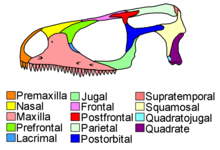
An anapsid is an amniote whose skull lacks one or more skull openings near the temples. Traditionally, the Anapsida are the most primitive subclass of amniotes, the ancestral stock from which Synapsida and Diapsida evolved, making anapsids paraphyletic. It is however doubtful that all anapsids lack temporal fenestra as a primitive trait, and that all the groups traditionally seen as anapsids truly lacked fenestra.

The Lepidosauria is a subclass or superorder of reptiles, containing the orders Squamata and Rhynchocephalia. Squamata includes lizards and snakes. Squamata contains over 9,000 species, making it by far the most species-rich and diverse order of non-avian reptiles in the present day. Rhynchocephalia was a formerly widespread and diverse group of reptiles in the Mesozoic Era. However, it is represented by only one living species: the tuatara, a superficially lizard-like reptile native to New Zealand.

Rhynchocephalia is an order of lizard-like reptiles that includes only one living species, the tuatara of New Zealand. Despite its current lack of diversity, during the Mesozoic rhynchocephalians were a speciose group with high morphological and ecological diversity. The oldest record of the group is dated to the Middle Triassic around 238 to 240 million years ago, and they had achieved a worldwide distribution by the Early Jurassic. Most rhynchocephalians belong to the group Sphenodontia ('wedge-teeth'). Their closest living relatives are lizards and snakes in the order Squamata, with the two orders being grouped together in the superorder Lepidosauria.

Lepidosauromorpha is a group of reptiles comprising all diapsids closer to lizards than to archosaurs. The only living sub-group is the Lepidosauria, which contains two subdivisions, Squamata, which contains lizards and snakes, and Rhynchocephalia, the only extant species of which is the tuatara.

Triadobatrachus is an extinct genus of salientian frog-like amphibians, including only one known species, Triadobatrachus massinoti. It is the oldest member of the frog lineage known, and an excellent example of a transitional fossil. It lived during the Early Triassic about 250 million years ago, in what is now Madagascar.
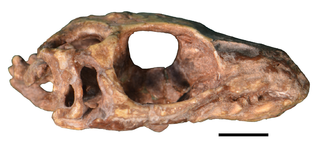
Eolacertilia is an extinct clade of lepidosauriform diapsid reptiles known from the Late Permian to the Late Triassic. It is uncertain as to whether they are a natural group and it has been suggested that they form a "waste basket" taxon. Currently, the only members of the group are Paliguana and Kuehneosauridae. Other genera were transferred to basal groups within Diapsida, Archosauromorpha.
Czatkobatrachus is an extinct genus of Early Triassic (Olenekian) salientian amphibians. It was first described in 1998 based on fossils found in the Czatkowice 1 quarry in Poland. It is, with Triadobatrachus, one of the two oldest known lissamphibians. More precisely, it is a member of Salientia; it is related to, but outside Anura, the taxon that includes all extant frogs. It is known only from the early Triassic of Poland. Its vertebral column may have been short as in other salientians, but the exact count is unknown. It had a short tail, and an elongated ilium. Although based on isolated and disarticulated material the surface preservation is exquisite.
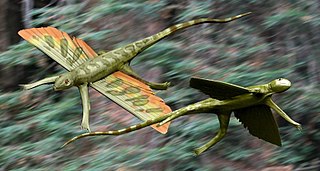
Kuehneosauridae is an extinct family of small, lizard-like gliding diapsids known from the Triassic period of Europe and North America.

Gephyrosaurus is an extinct genus of lepidosaurian reptile known from the Late Triassic to Early Jurassic of the United Kingdom. It is generally considered to be one of the most primitive members of the clade Rhynchocephalia.
Scythosuchus is an extinct genus of rauisuchid. Remains have been found from Olenekian-age Lower Triassic beds in Russia, hence the name meaning 'Scythian crocodile'. The type and only species is S. basileus, described in 1999. Scythosuchus was between 2 and 3 metres long, and relatively heavily built. It is known from a partial skull, much of the spine, a fragment of the humerus and most of the hind leg and foot. It may have been the same animal as Tsylmosuchus donensis.
Procolina is an extinct genus of procolophonid parareptile known from partial remains found in Early Triassic rocks of Czatkowice 1, Poland. It was first named by Magdalena Borsuk−Białynicka; and Mariusz Lubka in 2009 and the type species is Procolina teresae
Collilongus is an extinct genus of small archosauriform, possibly a rauisuchian, known from Early Triassic rocks of Czatkowice 1, Poland. It was first named by Magdalena Borsuk−Białynicka; and Andriej G. Sennikov in 2009. The type and only known species is Collilongus rarus. It is a rare component of the Czatkowice 1 fauna, known only from vertebrae. Collilongus was a contemporary of the more common archosauriform Osmolskina.
Czatkowiella is an extinct genus of long-necked archosauromorph known from Early Triassic rocks of Czatkowice 1, Poland. It was first named by Magdalena Borsuk−Białynicka and Susan E. Evans in 2009 and the type species is Czatkowiella harae.
Susan Elizabeth Evans is a British palaeontologist and herpetologist. She is the author or co-author of over 100 peer-reviewed papers and book chapters.

Jesairosaurus is an extinct genus of early archosauromorph reptile known from the Illizi Province of Algeria. It is known from a single species, Jesairosaurus lehmani. Although a potential relative of the long-necked tanystropheids, this lightly-built reptile could instead be characterized by its relatively short neck as well as various skull features.

Marmoretta is an extinct genus of small lepidosauromorph reptile known from the Middle Jurassic (Bathonian) of Britain, as well as the Late Jurassic of Portugal. It contains a single species, Marmoretta oxoniensis.
Pleurodontagama is an extinct genus of iguanian lizard from the Late Cretaceous of Mongolia. The type species, Pleurodontagama aenigmatodes, was named in 1984 on the basis of a mostly complete skull and isolated lower jaw from a fossil locality called Khermeen Tsav. It has a wide skull with a flat snout, large eye sockets, and small bumps on the surfaces of the bones. Pleurodontagama was initially classified in the family Priscagamidae, which is usually grouped in a large clade of iguanians called Acrodonta, members of which are characterized by an "acrodont" dentition in which the teeth grow from the margins of the jaws. However, Pleurodontagama is unusual in that it has a sub-pleurodont dentition, meaning that some of its teeth grow from the inner surfaces of the jaw. There is also evidence to suggest that its teeth may have been continuously replaced throughout life, as opposed to the permanent teeth of acrodontans. Pleurodontagama may have been a transitional form between the derived acrodont type and the pleurodont type inferred for the ancestors of Acrodonta.
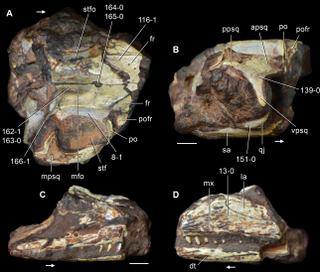
Kadimakara is an extinct genus of early archosauromorph reptile from the Arcadia Formation of Queensland, Australia. It was seemingly a very close relative of Prolacerta, a carnivorous reptile which possessed a moderately long neck. The generic name Kadimakara references prehistoric creatures from Aboriginal myths which may have been inspired by ice-age megafauna. The specific name K. australiensis relates to the fact that it was found in Australia. Prolacerta and Kadimakara were closely related to the Archosauriformes, a successful group which includes archosaurs such as crocodilians, pterosaurs, and dinosaurs.
Fraxinisaura is an extinct genus of basal lepidosauromorph reptile known from the Middle Triassic of Germany. The only known species is Fraxinisaura rozynekae. It possessed an elongated snout, unique features of the teeth, and an ilium which was intermediate in orientation between sphenodontians and squamates. Based on characteristics of the maxilla, it is considered a close relative of Marmoretta from the Middle Jurassic of the United Kingdom, resolving a ghost lineage between that genus and other Triassic basal lepidosauromorphs.
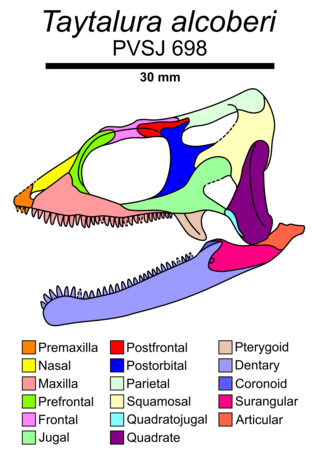
Taytalura is an extinct genus of lepidosauromorph reptile from the Late Triassic of Argentina. It contains a single species, Taytalura alcoberi, which is based on a well-preserved skull from the fossiliferous Ischigualasto Formation. As a lepidosauromorph, Taytalura is a distant relative of modern lepidosaurs such as sphenodontians and squamates. Taytalura did not belong to any group of modern lepidosaurs, since it bears unique features, such as unfused bones in the skull roof and teeth which all sit loosely in a deep groove without sockets. Regardless, Micro-CT scanning reveals features of the skull previously only seen in rhynchocephalians. This suggests that the ancestral condition of the skull in lepidosaurs was more similar to sphenodonts than to squamates.
